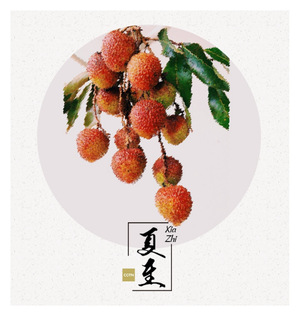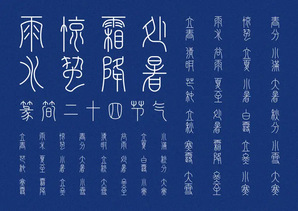"角簟碧纱厨,挥扇消烦闷。
唯有先生心地凉,不怕炎曦近。"
这两句词来自宋代诗人史浩所著的
《永遇乐·夏至》,意为:
隔着碧纱厨,躺在竹席上,
摇着扇子消解夏天的烦闷。
只有先生安然不动,心静自然凉,
不怕炎热临近。
Shi Hao, a poet of the Song Dynasty, mentioned in his poem Summer Solstice that:
Across a screen door, others are lying on the bamboo mat
and shaking a fan to drive away the boredom of summer.
Only the Master is calm and cool, not afraid of the approaching heat.

2022年的夏至将于6月21日到来,
近日,广州的天气也是几轮风雨几度晴,
闷热的天气与猝不及防的大雨组合在一起,
给老师和同学们的生活带来了不少令人哭笑不得的烦恼。
天气是这样难以捉摸,
生活在现代的我们依靠天气预报来得知次日的天气状况,
再根据其来制定我们的行程规划。
那么,古人又是怎样观测自然节律变化,
根据天气来进行农耕生产的呢?
答案便是二十四节气。
The 2022 summer solstice falls on June 21st.
Recently, the weather in Guangzhou has also been very changeable.
Suffocating heat and unexpected rain has brought a lot of trouble to the life of teachers and students.
Today, we rely on weather forecasts to know about the weather of the next day,
so that we can organize our daily lives accordingly.
However, how did ancient people observe the laws and changes of nature
and conduct farm production according to the weather?
The answer is the Twenty-four Solar Terms.
1. 什么是二十四节气?
“春雨惊春清谷天,夏满芒夏暑相连。秋处露秋寒霜降,冬雪雪冬小大寒。”
二十八个字的顺口溜为我们道出了
二十四节气的成员:
立春、雨水、惊蛰、春分、
清明、谷雨、立夏、小满、
芒种、夏至、小暑、大暑、
立秋、处暑、白露、秋分、
寒露、霜降、立冬、小雪、
大雪、冬至、小寒、大寒。
“二十四节气”是上古农耕文明的产物,
它是上古先民顺应农时,通过观察天体运行,
认知一岁中时令、气候、物候等变化规律所形成的知识体系。
一岁四时,春夏秋冬各三个月,
每月两个节气,每个节气均有其独特的含义。
在国际气象界,二十四节气被誉为“中国的第五大发明”。
2016年11月30日,二十四节气被正式列入联合国教育、科学及文化组织、人类非物质文化遗产代表作名录。
There are Twenty-four Solar Terms in total:
The Beginning of Spring, Rain Water, the Waking of Insects, the Spring Equinox,
Pure Brightness, Grain Rain, the Beginning of Summer, Lesser Fullness of Grain,
Grain in Beard, the Summer Solstice,
Lesser Heat, Greater Heat,
the Beginning of Autumn, the End of Heat,
White Dew, the Autumn Equinox,
Cold Dew, Frost's Descent,
the Beginning of Winter, Lesser Snow,
Greater Snow, the Winter Solstice,
Lesser Cold, Greater Cold.
The Twenty-four Solar Terms are the product of the Chinese ancient agricultural civilization,
as well as a knowledge system formed by ancient people to recognize the season, climate, phenology and other changes of the year,
in accordance with the agricultural time and through observing the movement of celestial bodies.
There are two solar terms in every month, each with its own unique meaning.
In the international meteorological community,
the Twenty-four Solar Terms are known as “China's fifth invention”.
On November 30th, 2016, the Twenty-four Solar Terms were officially inscribed on the Representative List of the Intangible Cultural Heritage of Humanity of the United Nations Educational, Scientific and Cultural Organization.

2. 二十四节气的历史来由
二十四节气起源于黄河流域,是古代中国劳动人民长期经验的积累和智慧的结晶。
远在春秋时代, 我国人民中就有了日南至、日北至的概念,定出仲春、仲夏、仲秋、仲冬等节气。
到战国后期成书的《吕氏春秋》“十二月纪”中,就有了立春、春分、立夏、夏至、立秋、秋分、立冬、冬至等八个节气,
它们是二十四个节气中最重要的节气,标示出季节的转换,清楚地划分出一年的四季。
再后来,《淮南子》一书中就有了和现代完全一样的二十四节气的名称。到秦汉年间,二十四节气已完全确立。
公元前104年,由邓平等制定的《太初历》,正式把二十四节气订于历法,明确了二十四节气的天文位置。
The Twenty-four Solar Terms originated in the Yellow River basin
and are the crystallization of the accumulated experience and wisdom of the ancient Chinese working people.
As far back as the Spring and Autumn Period,
Chinese people had the concept of the sun reaching to the south and the sun reaching to the north,
and fixed the solar terms such as mid-spring, mid-summer, mid-autumn and mid-winter.
By the late Warring States Period, Mister Lv's Spring and Autumn Annals listed eight solar terms including
the Beginning of Spring, the Spring Equinox,
the Beginning of Summer, the Summer Solstice,
the Beginning of Autumn, the Autumn Equinox,
the Beginning of Winter, the Winter Solstice.
They are the most important ones of the Twenty-four Solar Terms, clearly marking the four seasons of the year.
Later, in the book Huai Nan Zi, the names of the Twenty-four Solar Terms are exactly the same as those in modern times.
By the Qin and Han dynasties, the Twenty-four Solar Terms had been completely established.
In 104 BC, the Taichu Calendar, formulated by Deng Ping and others,
officially set the Twenty-four Solar Terms in the calendar
and defined the astronomical positions of the Twenty-four Solar Terms.
现行的“二十四节气”是依据太阳在回归黄道上的位置制定,
即把太阳周年运动轨迹划分为24等份,每15°为1等份,每1等份为一个节气,
始于立春,终于大寒。
经历史发展,农历吸收了干支历的节气成分作为历法补充,
并通过“置闰法”调整使其符合回归年,形成阴阳合历,
“二十四节气”也就成为了农历的一个重要部分。
The current “Twenty-four Solar Terms” are based on the position of the sun on the tropical zodiac,
that is, the annual movement of the sun is divided into 24 equal parts,
every 15 degrees stand for one equal part, each one equal part is a solar term,
starting from the Beginning of Spring to Greater Cold.

3. 二十四节气的作用
二十四节气准确的反映了自然节律变化,
从古到今都在人们日常生活中发挥了极为重要的作用。
在传统时代中,二十四节气最基本的功能与价值便是作为农业生产活动的基本时间指针。
由于传统时代有着“以农为本”的时间生活特点,
二十四节气亦是传统时代民众日常社会生活的重要时间节点。
对古代先民来说,二十四节气又不仅仅是一种指导农耕生产的时节体系,
更是包含有丰富民俗事象的民俗系统,
有着更为丰富多彩的生活内涵,是他们多彩生活的重要体现。
随着工业化、信息化、全球化的迅速发展,
今日的生产体系与社会生活已发生了极大变化,
二十四节气作为农业生产基本时间指针的作用日益减弱。
另外,随着现代工业生产的发展以及日历、钟表的推广与流行,
二十四节气作为民众日常生活时间节点的作用亦已基本不存。
不过,二十四节气在今日依然有着不可替代的当代价值。
The Twenty-four Solar Terms accurately reflect natural laws and changes,
and have played an extremely important role in people’s daily life since ancient times.
In traditional times, the most basic function and value of the Twenty-four Solar Terms
is as a basic time pointer for agricultural production activities,
especially as the traditional life was “agriculture-oriented”.
For ancient people, the Twenty-four Solar Terms were
not only a season system to guide agricultural production,
but also a folk system with rich folk customs,
which had more colorful life connotation and was an important embodiment of their colorful life.
With the rapid development of industrialization, informatization and globalization,
Today’s production system and social life have undergone great changes,
and the Twenty-four Solar Terms are increasingly weakening as a basic time pointer for agricultural production.
In addition, with the development of modern industrial production and the popularity of calendars and clocks, the Twenty-four Solar Terms have basically lost their function as time nodes in people’s daily life.
However, the Twenty-four Solar Terms still have irreplaceable contemporary value.
首先,作为一种历史悠久的时间知识体系并富含多彩活动的习俗传统,
二十四节气承载着深厚的精神文化内涵,含着悠久的历史积淀,是中华优秀传统文化的重要组成部分之一。
其次,作为古人的智慧,二十四节气能比较准确地反映自然的律动与节奏,体现了人与自然的和谐关系。
最后,二十四节气不单单是一种时间体系,更是一种充满丰富内涵的生活传统,是民众生活的重要组成部分,是有滋有味的“过日子”,将继续在现代民众的社会生活中发挥日常交往、休闲娱乐、饮食养生等方面的功用与价值。
First of all, as a time-honored knowledge system with rich customs and traditions,
the Twenty-four Solar Terms carry profound spiritual and cultural connotations and contain a long history of accumulation,
which is an important part of China’s outstanding traditional culture.
Secondly, as the ancient wisdom,
the Twenty-four Solar Terms can accurately reflect the laws of nature,
reflecting the harmonious relationship between man and nature.
Finally, the Twenty-four Solar Terms are not only a time system,
but also a life tradition full of rich connotations.
It is an important part of people’s life,
and it will continue to play a role in the social life of modern people in daily communication, entertainment, diet and health.
(策划/国际学院石牌校区学生党支部 文字/网络 齐盈泽 陈舞泓 图片/网络 编辑/章语涵 审核/方葳 终审/刘明)





